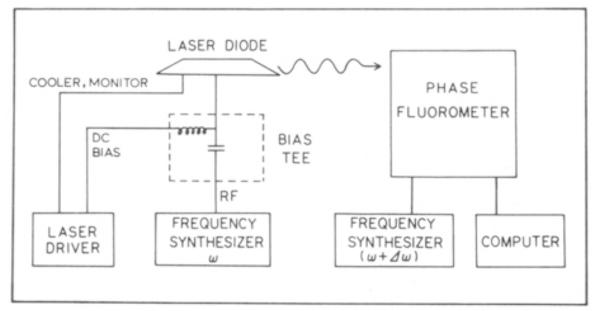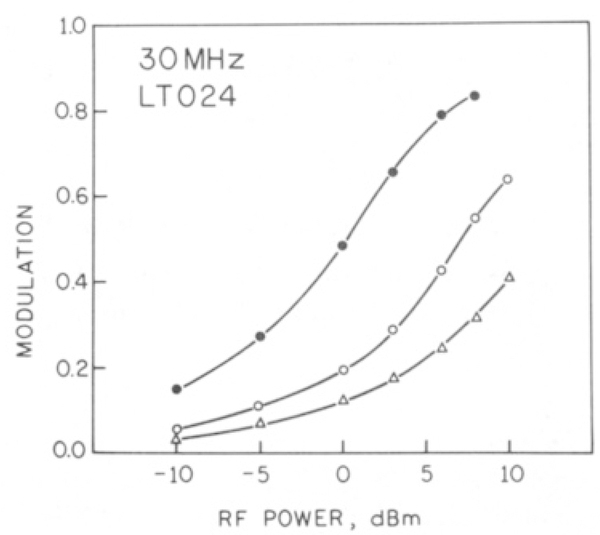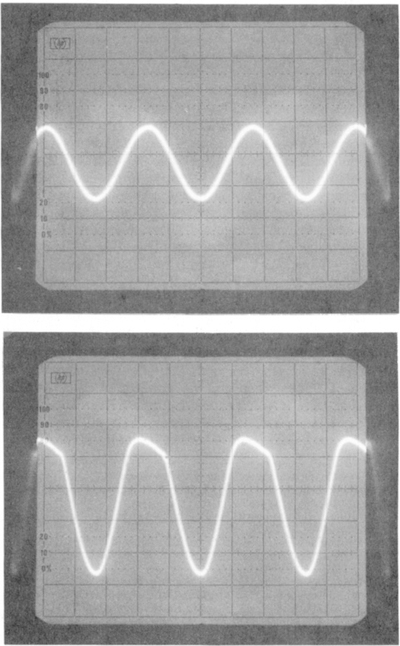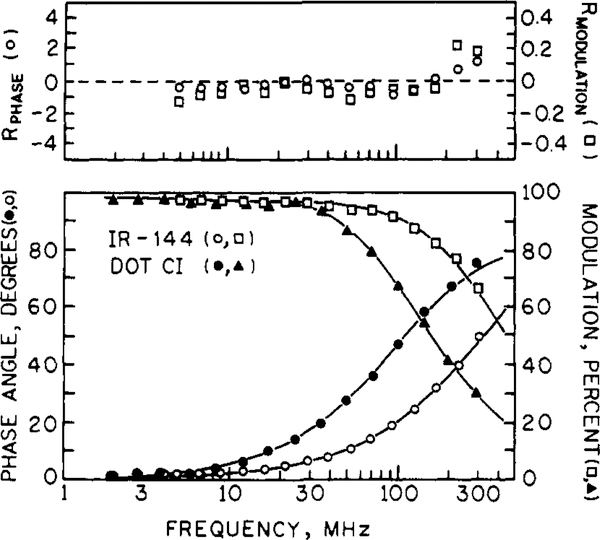Abstract
The authors report phase fluorometrlc measurements using directly amplitude-modulated 670- and 791-nm laser diodes as the excitation source. Fluorescence lifetimes ranging from 220 ps to 1.7 ns were measured using a commercial phase fluorometer. It was found that higher amounts of radio frequency power were required to achieve comparable degrees of modulation when the dc current on the diode was Increased and that rf power above a certain level created distortion In the light output. Results are shown for common cyanlne laser dyes emitting at wavelengths to 840 nm.
INTRODUCTION
Recently, there has been substantial interest in fluorometry in the near infrared (700–1100 nm). Use of fluorophores with emission in the infrared avoids background photoluminescence present in many matrices upon short wavelength excitation, such as serum and sea water.1–6 Moreover, infrared fluorometry is well suited to the use of diode laser sources, which are inexpensive, powerful, rugged, small, and reliable.6,7 In addition, blood and tissue exhibit less absorbance at wavelengths above 600 nm, and the v4 dependence of Rayleigh scattering means that many matrices opaque to shorter wavelengths, such as tissue and bone, are more transparent in the infrared.8 This suggests the use of fluorometry in certain in vivo diagnostic procedures. Finally, the greater transparency of silica optical fibers in the near infrared suggests that sensors based on infrared fluorometry may be capable of chemical detection at kilometer distances.9
Determinations of decay rate or lifetime are important to studies of fluorescence and its application to analytical chemistry. Some analytes can be determined directly by changes they induce in the lifetime of suitable probes.10–12 Several authors have pointed out9,12,13 that in comparison to fluorescence intensity measurements, fluorescence lifetimes are relatively insensitive to fluorophore bleaching and washout and fluctuations in excitation intensity. While fluorophores which exhibit wavelength shifts upon recognition of the analyte are also insensitive to the above problems, such fluorophores may be difficult to synthesize for a given analyte.14 Moreover, the use of long-lifetime fluorescent labels permits background fluorescence to be discriminated against by time resolution.15,16 Analogous discrimination against interfering fluorescence in the frequency domain can be provided by phase-sensitive detection of fluorescence.17 Finally, measurements of lifetime are vital for many biophysical studies.18
Infrared fluorescence lifetime determinations have been described using various laser sources, including pulsed laser diodes in the time domain.19 From our perspective, diode lasers are well suited for lifetime determinations in the frequency domain (phase-modulation fluorometry) since they do not require an external acoustooptic or electrooptic modulator. Rather, they can be directly modulated to frequencies in the gigahertz regime, which is beyond the frequency range available from electrooptic modulators, excepting LiNI3O3. Thus we employed a continuously modulated diode laser in our commercial-phase fluorometer to determine fluorescence lifetimes of some common infrared probes and laser dyes.
EXPERIMENTAL SECTION
We employed an ISS K2 phase fluorometer (Champaign, IL) with an emission monochromator, and the beam-splitting polarizer was removed to permit the laser diode light to be directed into the instrument. The laser diodes were a Sharp LT024 emitting up to 30 mW at 791 nm and a Toshiba TOLD 9211 emitting up to 3 mW, packaged with integral thermoelectric cooler and beam correction optics as catalog numbers 06 DOL 407 and 06 DOL 627, respectively, by Melles Griot Electro-Optics, Boulder, CO 80301. The output beam of both diodes is thus circular, collimated, and anastigmatic, and there is also provision for external modulation using a bias tee (Picosecond Pulse Labs Cat. No. 5575A) (Figure 1). By using a stabilized external current source (Melles Griot 06 DLD 203) the laser current was raised slightly above threshold (50 mA), and then rf power was applied to the bias tee (−5 to +5 dBm), producing substantial modulation as measured by the ISS or an avalanche photodiode (Antel) coupled through a Hewlett-Packard 8447D amplifier to a Hewlett- Packard 1725A oscilloscope. Under some circumstances the expected sinusoidal output of the laser diode exhibited marked distortion; this is discussed in more detail in Results. With care adequate modulation was obtained at all frequencies up to the 300-MHz limit of our Hamamatsu R928 photomultiplier tubes.20 Laser outputs were typically 2 mW at 670 nm and 7 mW at 791 nm at 50–55 mA dc bias as measured by a calibrated Newport 831-UV power meter. The low milliwatt levels of power used were quite adequate for our purposes and are comparable to the excitation levels ordinarily attained with externally modulated cw sources since the latter are attenuated at least 10-fold by electrooptic modulators and the additional optics (polarizers or Soleil-Babinet compensator) required. Frequency-dependent phase angles and modulations were measured for each sample versus a scattering solution (coffee creamer in water) and with a Glan-Thompson polarizer on the emission channel oriented 54° to the vertical to mitigate polarization effects. The data were fit using software provided by ISS or the Center for Fluorescence Spectroscopy at the University of Maryland at Baltimore.
Figure 1.
Schematic of laser diode amplitude-modulated through a bias tee. Other connections to the laser diode package provide current to the Peltier cooler and a photodiode monitor for the laser diode output.
The laser dyes 3,3′-diethylthiadicarbocyanine iodide (DTDCI), 3,3′-diethyloxatricarbocyanine iodide (DOTCI), 3,3’-diethylthiatricarbocyanine iodide (DTTCI), IR-144, and IR-140 were obtained from Kodak, and Indocyanine Green was obtained from Aldrich; all were used without further purification. Ethanol was analytical reagent grade or better, and water was distilled and subsequently purified through a Milli-Q system (Millipore); neither solvent exhibited detectable fluorescent impurities at the wavelengths of interest.
RESULTS
The apparatus depicted in Figure 1 permits modulation of the diode laser output by superimposing an rf signal onto the dc bias applied to the diode using a broadband bias tee. At the outset it was unclear to us what the optimum levels of dc bias level and rf power would be for achieving adequate modulation, minimum phase jitter, and maximum laser output and to what degree these factors would depend on the modulation frequency and the individual diode. We chose to bias the laser to different levels above threshold and measure the apparent modulation and optical power at selected modulation frequencies; the results of one such experiment for the 791 nm diode at 30 MHz are depicted in Figure 2. Among the useful findings was that at low bias levels, useful modulation could be obtained with modest rf powers, whereas increasing the bias level (and thus the laser output) requires much higher rf levels to obtain the same modulation (e.g., −1.5 dBm to achieve 40% modulation at 50-mA bias current, whereas +10 dBm is required at 70-mA bias). Of additional interest is the observation that at high rf powers the sinusoidal output of the laser was markedly distorted; for the case depicted in Figure 2, distortion became apparent at +10 dBm, while at 10 MHz (results not shown) distortion was not observed below +15 dBm. An example of this distortion is depicted as Figure 3, which shows oscilloscope tracings of the output of the diode laser when driven with low (1 mW) and high (10 mW) rf power. In this case the distortion of the sinusoidal output makes it appear somewhat more like a square wave. Under other conditions distortion of the basic wave form more resembled a superimposition of a second sine wave, or a sawtooth, or an apparent broadening of the trace, indicating jitter. Above the onset power levels indicated in Figure 2, the distortion becomes more marked with increasing power. Preventing optical feedback into the laser by slight misalignment of the system did not prevent the distortion. In addition, there seemed to be a minimum level of rf power necessary to achieve a clear wave form as judged from the oscilloscope trace; however, these levels corresponded to low levels of modulation, and in most experiments one would require greater modulation in any case. The effects were similar with both diodes, but the much smaller current range of the 670-nm diode in comparison to the 791-nm diode required greater care in its use and generally lower rf power (<0 dBm). We emphasize that these effects are likely to be present in varying degree in other diodes and that diodes should be individually checked in the frequency range of interest.
Figure 2.
Modulation of diode laser output at 791 nm as a function of rf power. Modulation was measured in the reference channel of the phase fluorometer as rf power at 30 MHz ranging from −10 dBm (100 μW) to +10dBm (10 mW) from the Marconi 2022A frequency synthesizer was varied. Data are shown for dc bias currents of 50 mA (solid circles, 7-mW laser output), 60 mA (open circles, 14 mW), and 70 mA (triangles, 19.3 mW).
Figure 3.
Distortion of diode laser output at high rf power. The 791-nm laser was operated at 50-mA bias with 1-mW (panel A, top) and 10-mW (panel B, bottom) rf modulation at 30 MHz through the bias tee; the laser output was monitored through a high-speed avalanche photodiode as described in the text. Each division on the oscilloscope graticule corresponds to 10 nanoseconds horizontally and 10 mV vertically.
Frequency-dependent phase angles and demodulation ratios are depicted for IR-144 and DOTCI, each in ethanol, versus a scatterer in Figure 4. The upper frequency limit for both data sets is determined by the R928 PMT20 and could in principle be extended by the use of an avalanche photodiode21 or red-sensitive microchannel plate PMT such as a Hammamatsu R1644U-01 with multialkali photocathode. The IR-144 data were well fit to a monoexponential decay of 593 ± 7 ps as judged by the usual criteria of nonsystematic residuals, and low χ2r(χ2r = 4.5). Furthermore, when the data were fit with two components, the first component was accurately recovered and represented 97 % or more; the second component had a nonsense, poorly defined value and a low fraction; and finally, the improvement in x2r was modest over the one component fit. These criteria all are consistent with the samples exhibiting monoexponential fluorescence decay. Photoisomerization such as that described22 for the cyanine dye 3,3′-diethyloxadicarbocyanine iodide was not observed, as expected for the conditions of excitation and emission that were chosen. Similar data were obtained for a range of infrared fluorophores using either the 670- or 791nm laser diodes as appropriate, and the results are summarized in Table I.
Figure 4.
Frequency-dependent phase shifts and demodulations for IR-144 in ethanol (open symbols) and DOTCI in ethanol (filled symbols) measured versus a scattering solution. Best one-component fits to each data set are Indicated by the lines. The upper panel depicts the residuals of the IR-144 data set on an expanded scale.
Table I.
| dyea | λexc | λem | τ | χ2R | lit. (ref) |
|---|---|---|---|---|---|
| DOTCI | 670 | 719 | 1.710 ± 0.015 | 4.2 | |
| DTDCI | 670 | 690 | 1.463 ± 0.015 | 15 | 1.278 (24) |
| DTTCI | 790 | 820 | 1.330 ± 0.016 | 21. | 2 (24) |
| IR-144 | 790 | 830 | 0.593 ± 0.007 | 4.5 | |
| IR-140 | 790 | 835 | 0.939 ± 0.010 | 4.1 | 1.20 ± 0.02 (23) |
| Indo. Green | 790 | 820 | 0.220 ± 0.006 | 6.2 | |
“Dye” indicates the name of the dye dissolved in ethanol; λexc is the wavelength of excitation, in nanometers; λem is the wavelength of emission, in nanometers; τ is the lifetime, in nanoseconds; χ2r is the reduced χ2; and “lit. (ref)” are values for the lifetime, in nanoseconds (under different conditions), measured by other workers, and the citation to their work.
The derived lifetime values are only somewhat close to those obtained by other workers.23,24 However, most of the values cited in Table I were obtained under different conditions using instrumentation demonstrated to be less precise. In particular, the data of Sibbett et al.24 were obtained by densitometric scans of the photographic output of a streak camera, which at that time was the predominant means of measuring picosecond decays; however, streak cameras are well-known to have a small dynamic range and low precision, which result in a very limited capability to resolve multiple decays when these are present. In addition, the concentrations of fluorophores used for the experiments of Sibbett et al.24 were 0.1 millimolar, which in our view is unacceptably high even though they discount the possibility of aggregation. The result of Birch et al.23 was obtained with acetone as a solvent, rather than ethanol. Finally, the excitation from the mode-locked dye laser or flashlamp23 (750 nm) is at a different wavelength than that of the diode laser(s). For all these reasons we feel the differences between our results and those of earlier workers are not a source of concern.
DISCUSSION
While phase fluorometry has been performed using directly modulated light emitting diodes13 and laser diodes in a pulsed mode,26 this is the first description of phase fluorometry employing a directly modulated laser diode. When modulated with a suitable level of rf power, the quality of the data in terms of the standard deviations of the individual phase measurements were always comparable to those seen with other amplitude modulated sources in our laboratories, and in some cases were overtly better. The issue of direct amplitude modulation of laser diodes assumes great importance in the arena of communications, where the modulation frequency attainable limits the rate of information transfer in optical fiber communication systems.26,27 This interest has generated a substantial body of work, both theoretical and experimental, aimed at maximizing the modulation frequency where high-fidelity transmission of the digital signal (expressed as a bit error rate) is achieved. From the standpoint of phase fluorometry, some of the factors which limit the modulation rate in the 1300- and 1500-nm-range diode lasers may influence our ability to obtain high-fidelity, high-frequency modulation at 665 and 791 nm. In particular, the well-known jitter in laser emission following pulsed excitation25,28–30 may represent a noise source in sinusoidally modulated sources as well. The larger standard deviations and residuals of the phase data at frequencies above 100 MHz present throughout our data (and note the residuals in Figure 4) suggest that such jitter may indeed be present. In general we would expect this problem to increase with frequency. Unfortunately, the applicability of the results for distributed feedback single-mode InGaAsP lasers operating at 1300 and 1550 nm to multimode GaAlAs or InGaAlP lasers operating below 900 nm is unclear.
The results make it clear that directly modulated laser diodes represent a useful and convenient light source for phase fluorometry. For reasons pointed out in the Introduction, laser diodes are attracting growing interest as sources in fluorometry and analytical chemistry. From the standpoint of time or frequency domain fluorometry, they offer the prospect of much simpler, more compact, inexpensive instrumentation than current laser-based devices. We note that Fedderson, et al.31 have recently described a cross-correlation multi-frequency phase fluorometer whose electronics reside on a single accessory board for a personal computer. Moreover, in the frequency domain diode lasers appear capable of offering the resolution and frequency range necessary for all but the most demanding experiments. At the present time the major obstacle to applications of fluorometry in the infrared is a shortage of suitable fluorescent probes. While several groups are pursuing this problem,1–4,32 it will be some time before a large, flexible selection of probes with capabilities comparable to current UV and visible probes becomes available. Nevertheless, the overt advantages of infrared fluorometry clearly will make the effort worthwhile.
ACKNOWLEDGMENT
We wish to thank the Office of Naval Research for support, and C. Villarruel of the Naval Research Laboratory for helpful discussions.
References
- (1).Ernst LA; Gupta RK; Mujumdar RB; Waggoner AS Cytometry 1989,10, 3–10. [DOI] [PubMed] [Google Scholar]
- (2).Mujumdar RB; Ernst LA; Mujumdar SR; Waggoner AS Cytometry 1989,10, 11–19. [DOI] [PubMed] [Google Scholar]
- (3).Southwick P,L; Ernst LA; Tauriello EW; Parker SR; Mujumdar RB; Mujumdar SR; Clever HA; Waggoner AS Cytometry 1990,11, 418–430. [DOI] [PubMed] [Google Scholar]
- (4).Patonay G; Antoine MD Anal. Chem 1991, 63, 321A–327A [Google Scholar]
- (5).Wolfbeis OS; Leiner M Anal. Chim. Acta 1985,167, 203–215. [Google Scholar]
- (6).Imasaka T; Ishibashi N Anal. Chem 1990, 62 (3), 363A–371A. [DOI] [PubMed] [Google Scholar]
- (7).Smith BW; Jones BT; Winefordner JD Appl. Spectrosc 1988, 42, 1469–1472. [Google Scholar]
- (8).Chance B, Ed. Photon Migration in Tissues; Plenum Press: New York, 1990. [Google Scholar]
- (9).Thompson RB In Topics in Fluorescence Spectroscopy Vol. 2 Principles; Lakowicz JR, Ed.; Plenum Press: New York, 1991; pp 345–365 [Google Scholar]
- (10).Bacon JR; Demas JN Anal. Chem 1987, 59, 2780–2785. [Google Scholar]
- (11).Keating SM; Wensel TG Biophys. J 1991, 59, 186–202. [DOI] [PMC free article] [PubMed] [Google Scholar]
- (12).Szmacinski H; Lakowicz JR In Proceedings of the SPIE Conference on Fiber Optic Medical and Fluorescence Sensors and Applications-, Proc. SPIE Vol 1648; Walt DR, Ed., in press. [Google Scholar]
- (13).Lippitsch ME; Pusterhofer J; Leiner MJP; Wolfbeis OS Anal. Chim. Acta 1988,205, 1–6. [Google Scholar]
- (14).Grynkiewicz G; Poenie M; Tsien RY J. Biol. Chem 1985,260, 3440–3450. [PubMed] [Google Scholar]
- (15).Soini E; Hemmila I Clin. Chem 1979, 25, 353–361. [PubMed] [Google Scholar]
- (16).Thompson RB; Vallarino LM In Time Resolved Laser Spectroscopy in Biochemistry. Proc. SPIE Vol. 909,1988; pp 426–433. [Google Scholar]
- (17).Lakowicz JR; Cherek HJ Biochem. Biophys. Methods 1985, 5, 19–35. [DOI] [PubMed] [Google Scholar]
- (18).Lakowicz JR Principles of Fluorescence Spectroscopy-, Plenum Press: New York, 1983. [Google Scholar]
- (19).Imasaka T; Yoshitake A; Hirata K; Kawabata Y; Ishibashi N Anal. Chem 1985, 57, 947–949. [Google Scholar]
- (20).Lakowicz JRln Photon Migration in Tissues; Chance B, Ed.; Plenum Press: New York, 1990; pp 169–186. [Google Scholar]
- (21).Berndt K Opt. Commun 1985, 56, 30–35. [Google Scholar]
- (22).Rulliere C Chem. Phys. Lett 1976, 43, 303–308. [Google Scholar]
- (23).Birch DJS; Hungerford G; Imhof RE Rev. Sci. Instrum 1991, 62, 2405–2408. [Google Scholar]
- (24).Sibbett W;Taylor JR; Welford D IEEJ. Quantum Electron 1981, QE-17, 500–509. [Google Scholar]
- (25).Berndt KW; Gryczynski I; Lakowicz JR Reu. Sci. Instrum 1990, 61, 1816–1820 [Google Scholar]
- (26).Stephens WE; Joseph TR IEEEJ. Lightwave Technol 1987, LT-5, 380–387. [Google Scholar]
- (27).Spano P; D’Ottavi A; Mecozzi A; Daino B; Piazzolla S IEEE J. Quantum Electron 1989, 25, 1440–1449. [Google Scholar]
- (28).Choy MM; Liu PL; Shumate PW; Lee TP; Tsuji S Appl. Phys. Lett 1985, 47, 448–450. [Google Scholar]
- (29).Mirasso CR; Colet P; San Miguel M Opt. Lett 1991, 16, 1753–1755. [DOI] [PubMed] [Google Scholar]
- (30).Farrens DL; Song P-S Photochem. Photobiol 1991,54,313–317. [DOI] [PubMed] [Google Scholar]
- (31).Fedderson BA; Piston DW; Gratton E Rev. Sci. Instrum 1989,60,2929–2936. [Google Scholar]
- (32).Rauhut MM; Roberts BG; Maulding DR; Bergmark W; Coleman RJ Org. Chem 1975, 40, 330–335. [Google Scholar]






